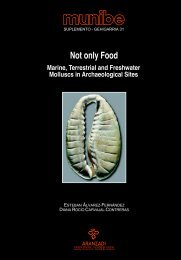PDF - Aranzadi
PDF - Aranzadi
PDF - Aranzadi
You also want an ePaper? Increase the reach of your titles
YUMPU automatically turns print PDFs into web optimized ePapers that Google loves.
PRÓLOGO<br />
El Pino Radiata en la Historia Forestal Vasca<br />
Análisis de un proceso de forestalismo intensivo<br />
RESUMEN<br />
Se analiza la historia y rentabilidad de las repoblaciones de pino radiata (Pinus radiata D.Don) realizadas en la Comunidad Autónoma<br />
de Euskadi durante el siglo XX. Actualmente esta especie de crecimiento rápido ocupa el 20% de la superficie total del territorio de la CAE<br />
y el 40% de la superficie forestal. Su amplia utilización en la zona Cantábrica ha dado lugar a un proceso desarrollado en varias fases: I -<br />
Iniciativas precursoras (1815-1871), II - Búsqueda de un modelo (1872-1917), III - Establecimiento (1918-1956), IV - Expansión (1957-1973),<br />
V - Contestación (1974-1989), y VI - Estabilización (1990-1997).<br />
Estas fases abarcan desde los primeros ensayos en el siglo XIX hasta finales del siglo XX. Las primeras repoblaciones del siglo XX fueron<br />
seguidas de una fase expansiva de la actividad repobladora a mediados del siglo XX que cuadriplicó la superficie previa, y tuvo una<br />
fuerte contestación en los años posteriores. Finalmente se estabiliza el proceso a finales del siglo XX. En esta actuación participa activamente<br />
el forestalista vasco, que ha contado desde la fase de establecimiento con el apoyo de la administración forestal. En los montes estudiados<br />
el propietario ha obtenido con esta especie una positiva rentabilidad.<br />
ABSTRACT<br />
An analysis is made of the history and profitability of reforestations of Monterey pine (Pinus radiata D. Don) in the Basque Autonomous<br />
Community during the 20th century. Currently, this fast-growing species occupies 20% of the total surface area of the Basque Autonomous<br />
Community and 40% of forested land. The extensive development of plantations of this species along the Cantabrica forest range can be<br />
divided in several stages: I - Previous initiatives (1815-1871), II - Search for a model (1872-1917), III - Establishment (1918-1956), IV -<br />
Expansion (1957-1973, V - Opposition (1974-1989) and VI - Stabilisation (1990-1997). These stages cover the period which began with the<br />
first trials conducted in the 19th century to the end of the 20th century. The first reforestations that took place in the 20th-century were followed<br />
by a period of expansion of reforestation activities in the mid 20th-century, when the previous surface area was quadrupled, leading to<br />
strong opposition in later years. Finally, the process was stabilised at the end of the 20th-century. The Basque forestry sector has participated<br />
actively in this process since the establishment phase, with the support of forestry authorities. Plantation owners have enjoyed positive<br />
profitability with this species.<br />
LABURPENA<br />
XX. mendean zehar Euskal Autonomia Erkidegoan Intsinis pinuaren (Pinus radiata D.Don) baso berritzearen historia eta errentagarritasuna<br />
aztertzen da. Hazkunde azkarreko espezie horrek, egun, EAEko lurralde osoaren %20 hartzen du, eta baso azaleraren %40. Kantauri<br />
itsasoko Isurialdean erruz erabili izan da, eta ezarpen prozesuak zenbait fase izan ditu: I - Ekimen aitzindariak (1815-1871), II - Eredu baten<br />
bila (1872-1917), III - Ezarpena (1918-1956), IV - Hedapena (1957-1973), V - Gizartearen erantzuna (1974-1989), eta VI - Egonkortasuna<br />
(1990-1997).<br />
Fase horiek XIX. mendeko lehen ezarpen saioetatik XX. mendera arteko ekimenak biltzen dituzte. XX. mendean egin ziren lehen baso<br />
berritzeak, eta, ondoren, XX. mendearen erdialdera, asko handitu zen baso berritze lana: landaketa horiek hartzen zuten azalera laukoiztu<br />
egin zen, eta gizarte erantzun handia izan zuen hurrengo urteetan. Azkenik, XX. mendearen amaieran jarduera egonkortu egin zen. Baso<br />
berritze lan honetan, euskal basozaleak buru-belarri hartu du parte, eta baso administrazioaren laguntza izan du ezarpen alditik. Jabeak<br />
errentagarritasun positiboa erdietsi du espezie honekin.<br />
MUNIBE (Suplemento / Gehigarria) 23, 2005 S.C. <strong>Aranzadi</strong>. Z.E. Donostia/San Sebastián<br />
XV

















